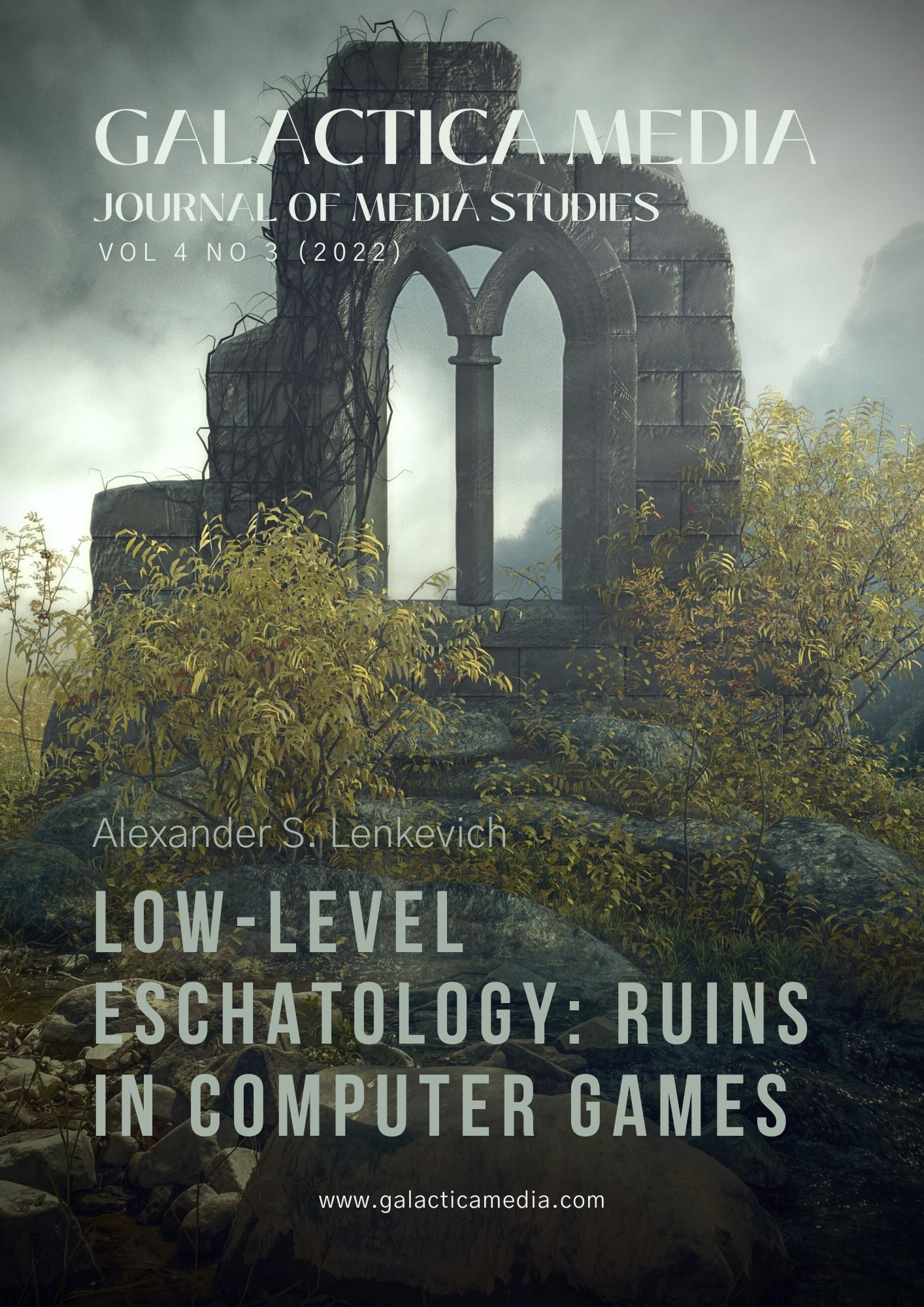Abstract
The ruins are a well-studied object in the history of culture. The article examines the ruins not only in terms of established approaches, but also from the perspective of media theory, visual ecology and game studies, new humanities oriented on exploring digital experience. Ruins in computer games, continuing the tradition of artificial ruins in European history, load the digital space with meaning, metaphysics, memory, stitch game and non-game contexts together and become a medium in its purest form — an intermediary that leads the gamer to the fragments of his identity, to the ruins of his inner experience. Digital ruins, fragmentary and partial in nature, reveal to us the pleasure of fragmentation and deconstruction that precede the new assemblage of reality. The article deals in addition with digital catastrophism, eschatology and ruinization in 11 bit studios games — This War of Mine (2014) and Frostpunk (2018).
References
Agamben, G. (2011). Homo Sacer: Sovereign Power and Bare Life. Europe. (In Russian).
Baudrillard, J. (1997). The City and Hate. Logos, 9, 107–116. (In Russian).
Baudrillard, J. (2006). Symbolic Exchange and Death. Dobrosvet, KDU. (In Russian).
Benjamin, W. (2012). On the concept of history. In The Study of Similarity. Media Aesthetic Works (pp. 237–253). RSUH. (In Russian).
Berdyaev, N. A. (1940). War and eschatology. Put’, 61, 3–14. (In Russian).
Beskhlebny, G. (2018). Frostpunk Demo. Snow and Frost vs. Steam and Moral Values. Igromania. https://www.igromania.ru/article/29920/Demoversiya_Frostpunk._Sneg_i_moroz_protiv_para_i_moralnyh_cennostey.html (In Russian).
Bolter, J. D., & Grusin, R. (1999). Remediation: Understanding new media. The MIT Press. https://doi.org/10.1108/ccij.1999.4.4.208.1
Burke, E. (1979). A Philosophical Enquiry into the Origin of Our Ideas of the Sublime and Beautiful (Vol. 237). Iskusstvo. (In Russian).
de Smale, S., Kors, M. J. L., & Sandovar, A. M. (2019). The Case of This War of Mine: A Production Studies Perspective on Moral Game Design. Games and Culture, 14(4), 387–409. https://doi.org/10.1177/1555412017725996
Descartes, R. (2006). Reasoning about the method. In Essays (pp. 93–131). Nauka. (In Russian).
Dillon, B. (2015). Fragments from the history of the ruins. Syg.Ma. https://syg.ma/@furqat/brain-dillon-fraghmienty-iz-istorii-ruin (In Russian).
Fuchs, M. (2017). “Ruinensehnsucht”: Longing for Decay in Computer Games. Transactions of the Digital Games Research Association, 3(2), 37–56. https://doi.org/10.26503/todigra.v3i2.68
Glazkov, I. (2020). 9 best real cities for virtual travel in games. Igromania. https://www.igromania.ru/article/31395/9_luchshih_realnyh_gorodov_dlya_virtualnyh_puteshestviy_v_igrah.html (In Russian).
Hobbes, T. (1989). The basics of philosophy. In Essays in two volumes (Vol. 1, pp. 66–622). Mysl. (In Russian).
Kasimov, H., Nezhinskaya, A., & Sinochkin, D. (2022). Why in 2022 in St. Petersburg stepped up demolition of historic buildings. Real Estate and Construction of St. Petersburg. https://nsp.ru/32568-s-nacala-2022-goda-v-peterburge-popali-pod-snos-uze-sest-istoriceskix-zdanii-pocemu-eto-proizoslo (In Russian).
Kłosiński, M. (2020). Frostpunk – tęsknota za biopolityką stanu wyjątkowego [Frostpunk—Longing for the biopolitics of the state of emergency]. Teksty Drugie, 1, 284–298. https://doi.org/10.18318/td.2020.1.18 (In Polish)
Kolesnikova, D. A. (2013). Visual Ecology. Studia Culturae, 15, 87–91. (In Russian).
Kolesnikova, D. A. (2016). § 1. Coordinates of visual ecology. In Visual Ecology: Shaping the Discipline (pp. 12–18). RCHA Publishers. (In Russian).
Kudryashov, M. (2016). The Anthropology of the Abandoned City. Part 2: How the Symbolic Attempts to Mend the Trauma of the Real. Syg.Ma. (In Russian). https://syg.ma/@lemonie/antropologhiia-zabroshiennogho-ghoroda-chast-2-kak-simvolichieskoie-pytaietsia-zaghladit-travmu-riealnogho (In Russian).
Latypova, A. R. (2016). § 15. Error Conversion: Glitch Art in Computer Games. In Media Philosophy XII. Game or Reality? Experiences in the study of computer games (pp. 263–280). Foundation for the Development of Conflictology. (In Russian).
Lishaev, S. A. (2015). The aesthetics of ruin. In A Yearbook of Phenomenological Philosophy (pp. 87–114). Russian State University for the Humanities Publishing Center. (In Russian).
Lisovsky, D. (2019a). “Assassin's Creed is unlikely to help,” Expert on the restoration of Notre Dame. ITMO-News. https://news.itmo.ru/ru/news/8428/ (In Russian).
Lisovsky, E. (2019b). Breaking is not building: How the idea of a destructible environment took over action games. DTF. https://dtf.ru/games/42086-lomat-ne-stroit-kak-ideya-o-razrushaemom-okruzhenii-zahvatila-ekshen-igry (In Russian).
Pogonyaylo, A. G. (2017). Thinking and Contemplation. Nauka. (In Russian).
Preciado, P. (2019). Notre-Dame-des-Ruines. Syg.Ma. https://syg.ma/@galina-1/pol-b-tochka-priesiado-front-zashchitnikov-notr-dama-ruin (In Russian).
Savchuk, V. V. (2013). Media Philosophy. An attack of reality. RCHA Publishers. (In Russian).
Savchuk, V. V. (2016). § 2 Prolegomena to the criteria for visual pollution. In Visual Ecology: Shaping the Discipline (pp. 19–44). RCHA Publishers. (In Russian).
Schönle, A. (2009). The Apology of Ruin in the Philosophy of History: Providentialism and its Decay. New Literary Review, 1, 24–38. (In Russian).
Simmel, G. (1996). Ruin. In Selected Works: Vol. 2: Contemplation of Life (pp. 227–233). Yurist. (In Russian).
Skomorokh, M. M. (2016). § 23. Visual ecology of computer game: Gamer's optics and the side effects of setting it up. In Visual Ecology: Shaping the Discipline (pp. 346–365). RCHA Publishers. (In Russian).
Toman, I. B. (2015). The Cult of Ruins. Fragments of History. Kulturolog. https://culturolog.ru/content/view/2386/121/ (In Russian).
Trigg, D. (2013). Psychoanalysis of the Ruins. Neprikosnovennyj zapas, 89. https://www.nlobooks.ru/magazines/neprikosnovennyy_zapas/89_nz_3_2013/article/10514/ (In Russian).
Trubina, E. G. (2013). Reconciling with Decline: Ruins 2.0. Neprikosnovennyj zapas, 89. https://www.nlobooks.ru/magazines/neprikosnovennyy_zapas/89_nz_3_2013/article/10516/ (In Russian).
Tucker, Yu. (2019). The Terror of Philosophy in Three Volumes: Volume 3: Tentacles Longer Than Night. Gile Press. (In Russian).
Vakhshtayn, V. S.* (2022). Imagining the City: An Introduction to Conceptualization Theory. New Literary Review. (In Russian).
Vella, D. (2010). Virtually in ruins: The imagery and spaces of ruin in digital games [Master Dissertation, University of Malta]. https://www.um.edu.mt/library/oar/handle/123456789/66592
Zenkin, S. N. (2001). French Romanticism and the Idea of Culture (Aspects of the Problem). RSUH. (In Russian).
Zhagun-Linnik, E. V. (2019). Problematization of Artistic Aspects of Glitch Art in Contemporary Glitch Studies. Artikult, 2, 69–78. https://doi.org/10.28995/2227-6165-2019-2-69-78 (In Russian).
* Included by the Russian Ministry of Justice in the register of foreign mass media performing the functions of a foreign agent

This work is licensed under a Creative Commons Attribution 4.0 International License.

